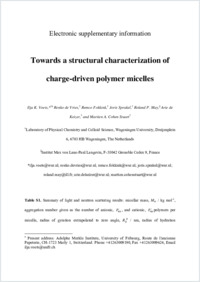Towards a structural characterization of charge-driven polymer micelles
- Voets, Ilja K. Laboratory of Physical Chemistry and Colloid Science, Wageningen University, Wageningen, The Netherlands - Adolphe Merkle Institute, University of Fribourg, Switzerland
- Vries, Renko de Laboratory of Physical Chemistry and Colloid Science, Wageningen University, Wageningen, The Netherlands
- Fokkink, Remco Laboratory of Physical Chemistry and Colloid Science, Wageningen University, Wageningen, The Netherlands
- Sprakel, Joris Laboratory of Physical Chemistry and Colloid Science, Wageningen University, Wageningen, The Netherlands
- May, Roland P. Institut Max von Laue-Paul Langevin, Grenoble, France
- Keizer, Arie de Laboratory of Physical Chemistry and Colloid Science, Wageningen University, Wageningen, The Netherlands
- Cohen Stuart, Martien A. Laboratory of Physical Chemistry and Colloid Science, Wageningen University, Wageningen, The Netherlands
-
12.12.2009
Published in:
- The European Physical Journal E. - 2009, vol. 30, no. 4, p. 351-359
English
Light scattering and small-angle neutron scattering experiments were performed on comicelles of several combinations of oppositely charged (block co)polymers in aqueous solutions. Fundamental differences between the internal structure of this novel type of micelle --termed complex coacervate core micelle (C3Ms), polyion complex (PIC) micelle, block ionomer complex (BIC), or interpolyelectrolyte complex (IPEC)-- and its traditional counterpart, i.e., a micelle formed via self-assembly of polymeric amphiphiles, give rise to differences in scaling behaviour. Indeed, the observed dependencies of micellar size and aggregation number on corona block length, N corona , are inconsistent with scaling predictions developed for polymeric micelles in the star-like and crew-cut regime. Generic C3M characteristics, such as the relatively high core solvent fraction, the low core-corona interfacial tension, and the high solubility of the coronal chains, are causing the deviations. A recently proposed scaling theory for the cross-over regime, as well as a primitive first-order self-consistent field (SCF) theory for obligatory co-assembly, follow our data more closely.
- Faculty
- Faculté des sciences et de médecine
- Department
- AMI - Soft Nanoscience
- Language
-
- English
- Classification
- Physics
- License
-
License undefined
- Identifiers
-
- RERO DOC 17029
- DOI 10.1140/epje/i2009-10533-4
- Persistent URL
- https://folia.unifr.ch/unifr/documents/301311
Other files
Statistics
Document views: 106
File downloads:
- pdf: 226
- Supplementary material: 141

